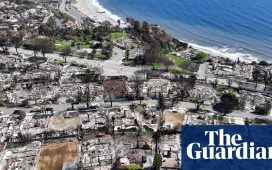The war in Ukraine and extreme weather events have driven up the cost of reinsurance by as much as 200 per cent in crucial January renewals, according to a new report, threatening to raise premiums and reduce what insurers are willing to cover.
January 1 is the key policy renewal date for reinsurers, which share losses with primary insurers and so have a vital role in what can be insured and at what price. This year’s renegotiation of reinsurance policies has been the most challenging in years as reinsurers respond to pressure from spiralling inflation and large losses from natural catastrophes, as well as the fallout from Russia’s invasion of Ukraine.
James Kent, global chief executive at reinsurance broker Gallagher Re, which published the report on Tuesday, described it as a “very late, complex and in many cases frustrating renewal”.
The cost of aerospace reinsurance rose by between 150 per cent and 200 per cent, as reinsurers adjusted pricing in the light of a revaluation of past losses, as well as expected payouts from stranded planes and a legal battle with leasing companies in the wake of Russia’s invasion of Ukraine.
Property catastrophe reinsurance, which shoulders losses from hurricanes and other natural disasters, also jumped, with rates in the US increasing by between 45 per cent and 100 per cent for loss-hit policies, according to Gallagher Re’s figures. The broker put this down to the impact of Hurricane Ian, which struck Florida and South Carolina last year, as well as the threat from inflation, which drives up payouts.
“For property, this is the year that reinsurance has got back in the driving seat and they’ve been very firm,” Gallagher Re’s international chair James Vickers told the Financial Times. “They haven’t cracked.” He described the reinsurance negotiations as the “toughest [market] since 9/11”.
In a report also published on Tuesday, broker Howden said the cost of property catastrophe reinsurance had increased by 37 per cent globally in the January renewals, the largest rise in comparable data running back to 1992. Howden called it “one of the hardest reinsurance markets in living memory”, using an industry term for a period of sustained price rises.
Higher reinsurance prices and the reduced availability of some cover typically feed through to the prices that insurers charge and what they are willing to offer, although they can also choose to write business “net”, or without reinsurance cover. The reinsurance price rises are expected to further fuel what is already a years-long upswing in insurance prices for companies.
An update on the January 1 negotiations last week from Guy Carpenter, another of the big reinsurance brokers, described it as “one of the most challenging reinsurance markets the sector has experienced”, with some reinsurers’ initial requests to modify coverage “threatening to erode the core value of the reinsurance product”.
Property was the hardest renegotiation in what was a “stressed” sector, it said, with substantial price rises and worse terms.
Another factor in rising reinsurance prices has been a capacity squeeze, as reinsurers pull out of areas such as property catastrophe reinsurance. But the brokers reported that the degree of price rises in the January 1 renewals had lured some new capacity into the market, for instance by underwriters raising fresh capital.
“It’s important to remember that we have been at crossroads before,” commented Guy Carpenter’s president, Dean Klisura, pointing to the market corrections that followed events such as the September 11 terrorist attacks on the US and Hurricane Andrew.
Reinsurers have also pushed to restrict or exclude Russia, Ukraine and Belarus from some areas of coverage, Gallagher Re said. The wider pullback from reinsuring assets is already having ripple effects: last month, western shipping insurers said they would exclude losses coming from the conflict, following a move from their reinsurers to reduce exposure.
Also in December, Nikkei Asia, the FT’s sister publication, reported that the Japanese government had intervened after local insurers said they could no longer offer coverage for ship damage in Russian waters — also pointing to western reinsurers’ decision to remove coverage.











